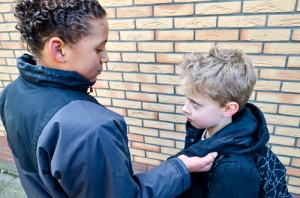 PACER Center was founded in 1977 by parents of children and youth with disabilities. It was formed with the mission of helping these young people and their parents and their families face the resulting challenges, and expand their opportunities. It remains staffed primarily by parents of children who have disabilities, and provides assistance to families; materials for both parents and professionals; and workshops and leadership in the ongoing effort to secure appropriate and free public education for all children. In 2006, PACER founded the National Bullying Prevention Center, raising awareness of bullying as a serious community issue which impacts education, emotional and physical health, and the safety and well-being of students.
PACER Center was founded in 1977 by parents of children and youth with disabilities. It was formed with the mission of helping these young people and their parents and their families face the resulting challenges, and expand their opportunities. It remains staffed primarily by parents of children who have disabilities, and provides assistance to families; materials for both parents and professionals; and workshops and leadership in the ongoing effort to secure appropriate and free public education for all children. In 2006, PACER founded the National Bullying Prevention Center, raising awareness of bullying as a serious community issue which impacts education, emotional and physical health, and the safety and well-being of students.
PACER’s National Bullying Prevention Month
National Bullying Prevention Month was founded by PACER in 2006, and is held annually during the month of October. It is a time set-aside for communities across the nation to come together and raise awareness of bullying prevention through education, activities and events.
During National Bullying Prevention Month, as well as throughout the year, PACER encourages the community to use the creative resources its organization provides to educate and inspire others to join the movement. These resources to support the organization mission to prevent bullying of our children can be found on the PACER website.
Bullying
Bullying is considered to be any aggressive or unwanted behavior that mistreats, humiliates, or intimidates another human being who is more vulnerable, or somehow weaker, than the one who bullies. It can also include the person using force or some sort of coercion to abuse or intimidate another human being; often in a manner that is methodical and habitual.
Bullying may be as simple as speaking or writing words about another person in a mean-spirited way, and frequently on an ongoing basis. It may be as complex as a series of actions undertaken with the intention of undermining an individual’s name, reputation or business. Bullying may also–and sometimes does–result in serious injury and even death; even if that may not have been the original intention of the individual doing the bullying.
The U.S. Department of Health and Human Service details that bullying often begins with school-age children, and may include three types of behavior and actions:
- Physical bullying, such as hurting another person’s body by kicking, hitting, punching; pushing or tripping: or taking or breaking someone else’s possessions.
- Verbal bullying, such writing or saying or mean things; name-calling, taunting or teasing or threatening to cause harm.
- Social and/or relationship bullying, such as hurting another person’s relationship or their reputation through spreading rumors about the person or embarrassing them in public; excluding the person from activities or groups on purpose; or telling other people not to make friends with the person.
- Cyber-bullying, which usually combines social and verbal bullying by means of different forms of electronic technology, such as internet, social media, cell-phone texting.
Experience demonstrates that boys are more likely to engage in physical bullying, and girls are more likely to participate in social and/or relationship bullying.
Substance Abuse and Bullying
Narconon Arrowhead, the Oklahoma-based drug rehabilitation and education center, shares some insight into the link between substance abuse—and bullying.
A 2012 study published in Addictive Behaviors suggests that students who are bullying their classmates are more likely to smoke cigarettes, and use marijuana and alcohol compared to their peers who do not bully others.
The lead author of the study detailed that the findings suggest “one deviant behavior may be related to another”, meaning youth who bully others may also be more likely to try substance use; and those who use substances may also be more likely to bully others.
A survey of nearly 75,000 students was reviewed by the researchers, including questions on substance abuse and bullying. Based on the survey results, bullying was found to more common amongst middle-school students than it was in high school students; and substance use was found to be more common amongst high school students.
Researchers also found that 11.4 percent of bullies reported marijuana use, while only 1.6 percent of the students in middle-school who were not involved in bullying, reported using marijuana.
Amongst the high school students, 31.7 percent of the bullies reported using marijuana, while only 13.3 percent of those not engaged in bullying reported using marijuana. The research study found similar results for cigarettes and alcohol.
It was also detailed by the lead author of the study that the opportunity to address substance use should be included in school anti-bulling policies and programs; taking the opportunity to intervene at the middle-school level with bullies in an effort to help them before they begin experimenting with substance use.
Source: